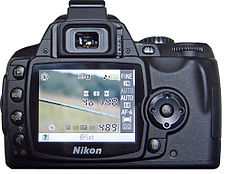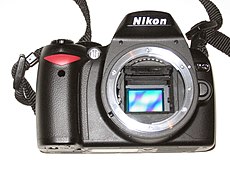The topic of this article may not meet Wikipedia's
notability guidelines for products and services. (January 2020) |
 | |
| Overview | |
|---|---|
| Type | Digital single-lens reflex |
| Lens | |
| Lens | Interchangeable Nikon F-mount |
| Sensor/medium | |
| Sensor | Nikon DX format 23.7 mm × 15.6 mm (0.93 in × 0.61 in) CCD |
| Maximum resolution | 3,008 × 2,000 (6.1 effective megapixels) |
| Film speed | ISO 200-1600, ISO 3200 in high mode |
| Storage media | Secure Digital, SDHC up to 32GB |
| Focusing | |
| Focus modes | autofocus: single (AF-S); continuous (AF-C); auto selection (AF-A); Manual |
| Focus areas | 3 sensors, Multi-CAM530 |
| Exposure/metering | |
| Exposure modes | Manual, Aperture Priority, Shutter Priority, Program and preset settings: Auto, Portrait, Landscape, Child, Sports, Macro, and Night Portrait |
| Exposure metering | 420 segment color meter |
| Metering modes | 3D Color Matrix, Center-weighted and Spot |
| Flash | |
| Flash | i-TTL Built-in or hotshoe (e.g. for the matching SB-400 Speedlight) |
| Shutter | |
| Shutter speed range | 1/4000 to 30 seconds, bulb; 1/500 Flash X-Sync |
| Continuous shooting | 2.5 frame/s, 100 JPEG frames buffer |
| Viewfinder | |
| Viewfinder | optical, through the lens, pentamirror type, 0.8× magnification, 95% coverage |
| General | |
| LCD screen | 2.5", TFT, 230,000 pixel, 170° angle of view |
| Battery | 1,000 mAh lithium-ion EN-EL9 |
| Dimensions | 126 mm × 94 mm × 64 mm (5.0 in × 3.7 in × 2.5 in) |
| Weight | 475 g (16.8 oz) without battery 524.1 g (18.49 oz) with battery [2] 729 g with battery and AF-S DX Zoom-Nikkor 18-55mm f/3.5-5.6G ED II kit lens [3] |
| Made in | |
The Nikon D40 is a 6.1-megapixel DX format DSLR Nikon F-mount camera announced by Nikon on November 16, 2006. It replaces the D50 as Nikon's entry level DSLR. It features a 2.5-inch 230,000-dot resolution LCD monitor, CCD sensor with ISO 200-1600 (3200 Hi-1) and 3D Color Matrix Metering.
The D40 was superseded by the D40X in March 2007.
Features
- 6.1-megapixel Nikon DX format CCD Sensor
- 23.7 mm x 15.6 mm sensor size
- SD and SDHC memory card file storage
- ISO 200-1600. Hi-1 (ISO 3200)
- 2.5-inch color LCD monitor with 3 colorful display options
- File formats: JPEG, NEF (Nikon's RAW, 12-bit compressed
- Nikon F-mount lenses
- 3-area auto focus
- Image assist
- Fires continuously at a speed of up to 2.5 frames per second
- EN-EL9 Lithium-ion battery
- Built-in speedlight with i-TTL automatic flash control
- Flash sync speed up to 1/500 sec
- In-camera retouching
Reception
Reviews of the Nikon D40 have been generally favorable due to its ergonomics and image quality. [4] It received some criticism for some design compromises Nikon undertook to keep the D40's price and size competitive. [5]
Nikon D40x
On March 6, 2007, Nikon introduced the D40X, a sister camera to the D40. [6] While identical in external design to the D40, it has a 10.2-megapixel CCD sensor, continuous shooting up to 3 frames per second, and a base sensitivity of ISO 100. It has a flash sync speed of 1/200 seconds.
A new consumer-level telephoto zoom with vibration reduction debuted alongside the launch. Nikon ceased production of the D40X in December 2007, shortly before they introduced its successor, the Nikon D60.
Gallery
-
Rear panel of the D40
-
Showing the DX sensor of the D40
-
Nikon D40X with AF-S 18-55mm f/3.5-5.6G kit lens and SB-400 flash unit
See also
References
- ^ "Nikon D40". Products Line Up. Nikon Corporation. Archived from the original on 2008-03-06.
- ^ "Nikon D40 Specifications". Ken Rockwell. Retrieved 2012-12-18.
- ^ "AF-S DX Zoom-Nikkor 18-55mm f/3.5-5.6G ED II". Nikon Americas.
- ^ "Digitalcameratracker.com: Nikon D40 Review". Archived from the original on 2010-12-31.
- ^ Askey, Phil (December 2006). "Nikon D40 Review". Digital Photography Review. Retrieved 2010-01-02.
- ^ "Nikon D40x" (Press release). Nikon Corporation. 2007-03-06. Archived from the original on 2007-12-13.



